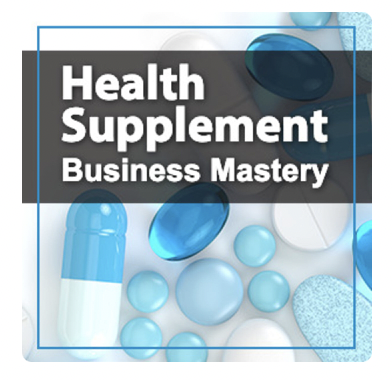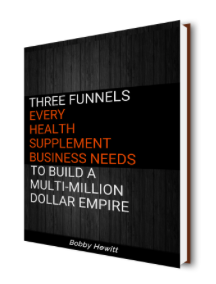The path to a successful direct to consumer dietary supplement business is not always straight forward. In fact, it rarely ever is.
Not every supplement business owner takes the same path.
But most of the time the path to success leaves clues.
Those clues are outlined in these seven stages of supplement business success.
One clue every single direct to consumer dietary supplement business has is a supplement sales funnel.
A funnel brings in new buyers on a consistent basis. But in order to get to that point most supplement businesses start out pretty rough.
Let’s take a look at the seven stages of success.
Stage One – Floundering
Your first supplement sales funnel is typically flat out of the gate. Meaning no sales or only a small handful of sales. Many supplement companies die on the vine right here, never getting to stage two.
This is what I call the floundering stage. You’re not sure what’s not working and you’re struggling to fix it. Not sure if it’s fixable with a few tweaks or if you should scrap the whole thing and start fresh.
Those that make it, simply keep at the work much longer than those that don’t. Changing and investing in what is needed to get to the next stage keep them afloat.
Many start by selling on Amazon as a way to generate cashflow. This can be a double edged sword. A previous article about selling supplements on Amazon goes into the reason why. You can read more about that there.
As a side note, funding growth with cashflow is not only very limiting but often times impossible. Because the next level is typically a much higher increment that requires a cash runway that’s typically not possible with cashflow. A larger investment is often needed to make an online supplement business really work.
In order to take a cold traffic supplement sales funnel that consistently brings in new customers that you can scale, you need to feed it.
What you feed it is time and traffic.
You need enough traffic to really know if it’s working and to see how you can improve it. My recommendation is that your advertising spend should be at least $160 per day for 3 months to really get any meaningful insights and learnings.
During that time you’re dialing in your ad campaigns and optimizing for cost per action and at the same time you’re starting to do the same on the front-end sales page with at least one A/B test.
But the traffic and the A/B testing never ends. The testing and optimizing for sales is the whole game when optimizing a funnel.
Not giving your funnel a chance by not feeding it meaningful traffic is what kills many small supplement companies. They never make it to the next stage.
Stage Two – It’s Working
In stage two, the offer shows signs of working.
Your getting some learnings and some lifts with your A/B testing on the front-end sales page.
Maybe you’re testing the marketing lead copy, maybe you’re testing the hook, maybe you’re testing the offer. In any case you’re testing big levers here not small things like button colors.
On the traffic and advertising side you’re testing ad creative images, video and ad copy.
It’s important to note that getting to stage two will likely take longer than three months.
I mentioned three months of traffic in stage one. I want to be clear about this. It will take longer than three months to get to the “It’s working” stage.
Every market and offer is different.
Some are more saturated than others, some products are more me-too than others. All of these factors and more contribute to how long it takes. The quality of the ideas, hooks and A/B testing strategy also contribute quite a bit to how long it takes to get through this stage.
Typically this second stage shows signs of working. An indication that you can add more traffic to the campaign. Maybe you’re now willing to spend $250 a day.
You’re getting there.
Stage Three – Scale
This is the stage where A/B testing optimization enters a whole new world. You can test faster, and test deeper into the funnel.
Typically this is when most of our clients come to us for help.
If you just entered stage three, you’re scaling slowly here.
Most business owners want to scale quicker than they can or should, and often derail the wheels as a result of going too fast. You can, and should get to the point of $20,000 a day spend in ad traffic but not all at once.
Stage Four – Setbacks
Everything is working (or starting to work) sales are rising, your A/B testing is showing improvements and you’re bringing in more buyers… and then the wheels fall off.
Often these setbacks are unexplainable. It seems like the wind changes and suddenly your campaign is off the rails. Cost per acquisition (CPA) shoots up, conversion tanks.
If an offer was working or showing signs of working and no changes were made to the sales copy or the offer, then it’s not the offer or the copy.
I’ve seen this before. Here are a few of the reasons why this happens.
- A change in the marketplace – A marketplace shift typically means a new competitive offer has entered the marketplace or the sophistication level of your audience has changed.
- The traffic algorithm changes – Typically, Facebook or Google the two traffic giants, make a change that effects your campaign. This can also effect the quality of the traffic which will effect the conversion rate of sales.
- A mis-management of the traffic campaign – Ad campaigns need constant monitoring and tweaking to stay on track. If they are not managed correctly they slow or in some cases very quickly degrade over time.
- A technical issue – Sometimes things just break for no reason. I’ve seen it before. No changes were made to any code but the button is no longer working.
Any one of these things can totally derail your working campaign.
Stage Five – Building
In this stage, you’re increasing your product line and adding new supplements, information products, and physical products.
The engine of growth begins to start ramping up in this building stage. More content is typically needed here.
Content at this stage comes in the form of articles to position and build your brand, email content and good old direct response sales copy for additional funnels. These are the funnels that ascend your buyers to buy more, raising their life time value.
But, Let’s Not Forget About The Backend…
To learn more about the difference between the backend and the front end read this article.
The backend is where most of the money is made, and the amount you make is directly correlated with the offer used to bring in a new buyer. A free plus shipping offer on the front end is typically not going to generate as high a life time value as a hard offer.
You should start thinking about, if not developing, your backend offers in stage one. Typically this is not the case however. You’ve got enough spinning plates to manage, with formulations and product sourcing much less selling and building a funnel, to worry about. Often the backend takes a back seat. It makes sense because you haven’t built up the front end or a customer base yet, then selling them more later is the last thing on your plate. You’re just trying to stay in business at this point and get this supplement company off the ground.
Stage Six – Control
Your head of operations really starts to kick in. Fulfillment comes back into your hands and customer service as well. Many companies build in-house teams to handle calls and customer service.
In this stage, you’re streamlining operations and reducing overhead. In addition to lowering your cost of goods and increasing your profit margins.
It’s The Same, But Different
Every successful direct to consumer supplement company goes through virtually the same set of stages.
“There is no failure only feedback”, as I say in the world of a/b testing and optimization. That stoic approach coupled with resilience to weather the tough times will help to get you to the next stage. In addition to having a clear vision and goals.
It’s very easy to get off track especially when you start looking at competitors.
Yes, you should still keep an eye on what your competitors are doing. But don’t allow yourself to follow them. Take your own unique approach, analyzing and then tweaking along the way.
What stage are you in and where are you going next?
Discover the 3 funnels that can help your health supplement business succeed.

Listen to the Health Supplement Business Mastery Podcast for for dietary supplement entrepreneurs and marketers.



